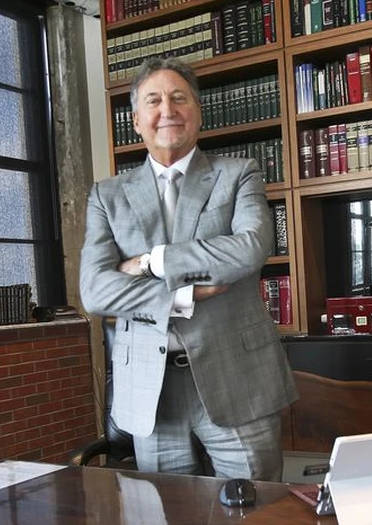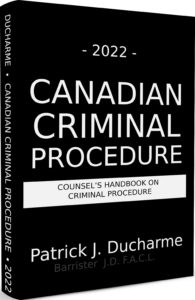 |
| Patrick Ducharme |
Section 548 provides the test: to determine if there is sufficient evidence to put the accused on trial for the offence charged or any other indictable offence in respect of the same transaction.
The duty imposed upon a Justice under section 548 is the same duty that governs a trial Judge sitting with a jury in deciding whether the evidence is insufficient to the point that a directed verdict of acquittal should be ordered, and, is also the same duty imposed upon a Judge asked to decide on whether a person should be extradited.
548(1): When all the evidence has been taken by the Justice, he shall,
if in his opinion there is sufficient evidence to put the accused on trial for the offence charged or any other indictable offence in respect of the same transaction, order the accused to stand trial; or
discharge the accused, if in his opinion on the whole of the evidence no sufficient case is made out to put the accused on trial for the offence charged or any other indictable offence in respect of the same transaction.
Although the main purpose of a preliminary inquiry is to determine whether there is sufficient evidence to order the accused to stand trial pursuant to section 548, it has generally been considered appropriate for an accused to be afforded the statutory right to make a statement, to call witnesses and to have full rights of cross examination in an attempt to demonstrate that there is insufficient evidence to warrant a trial.
Mr. Justice Hill, in R. v. Walker2 held that an accused is not entitled to cross-examine police officers concerning the identity of informers used in the case, even if the accused can demonstrate that the informer’s identity is necessary to establish innocence. The Justice concluded that the accused’s innocence is not at stake at a preliminary inquiry and therefore the questioning is prohibited by the public interest privilege.
Informer privilege is subject only to the “innocence at stake” exception that was established by the Supreme Court of Canada in Leipert.3 According to the Walker case, the exception to the privilege protection can only be recognized at trial. The preliminary inquiry is not meant to determine the accused’s guilt or innocence. That finding is made at trial.
The preliminary inquiry also serves as a screening vehicle, permitting prosecutors to assess their case and determine whether or not particular charges should proceed to trial. The preliminary hearing is not meant to provide a forum for litigating the merits of the case against the accused.
Instead, the primary function of a preliminary hearing is to determine whether the Crown is able to produce sufficient evidence to warrant committing the accused to trial.5 The preliminary hearing is a pre-trial screening hearing aimed at filtering out weak cases that do not merit trial.
Its paramount purpose is to “’protect the accused from a needless, and indeed, improper, exposure to public trial where the enforcement agency is not in possession of evidence to warrant the continuation of the process.” The Justice evaluates the admissible evidence to determine whether it is sufficient to justify requiring the accused to stand trial.
The Crown is not required to call any witnesses at a preliminary inquiry at the request of the accused or the court. Decisions on how to present evidence against an accused are entirely within the Crown’s discretion. The Crown has no obligation to afford the defence an opportunity to discover the Crown’s case.7 The Crown has the right to present only that evidence that makes out a prima facie case. The presiding Justice may permit the accused to be absent from court in accordance with subsection 537(1)(j.1). If the Justice permits the accused to be absent, the court must inform the accused that the evidence taken in her absence may nevertheless be admissible at the trial under s. 715. Section 715 provides as follows:
715(1) Where, at the trial of an accused, a person whose evidence was given at a previous trial on the same charge, or whose evidence was taken in the investigation of the charge against the accused or on the preliminary inquiry into the charge, refuses to be sworn or to give evidence, or if facts are proved on oath from which it can be inferred reasonably that the person
(a) is dead,
(b) has since become and is insane,
(c) is so ill that he is unable to travel or testify, or
(d) is absent from Canada,
and where it is proved that the evidence was taken in the presence of the accused, it may be admitted as evidence in the proceedings without further proof, unless the accused proves that the accused did not have full opportunity to cross-examine the witness.
Consequently, an order permitting the accused to be absent from the preliminary hearing still permits the prosecutor later to invoke the provisions of section 715 despite the words, “where it is proved that the evidence was taken in the presence of the accused”.
Pursuant to section 556 an organization appears at the preliminary inquiry by counsel or agent. If the organization has been served with the summons and does not appear the Justice is entitled to set a date for trial.
A Justice acting under this Part shall order the immediate cessation of any part of an examination or cross-examination of a witness that is, in the opinion of the Justice, abusive, too repetitive, or, otherwise inappropriate.
A preliminary inquiry is a pre-trial procedure to determine whether an accused should stand trial for an indictable offence. The rules related to preliminary inquiries are governed by Part XVIII of the Criminal Code. The purpose of the inquiry is to determine whether the prosecution can produce “sufficient” evidence to warrant ordering the accused to trial. If the court determines there is sufficient evidence for the offence charged, or, in respect of any other indictable offence arising out of the same transaction, to order the accused to stand trial, it will order committal to trial pursuant to section 548.
A determination that there is sufficient evidence leads to an order of committal. A finding that the evidence is insufficient leads to an order of discharge. An order of discharge in relation to the offence charged is not necessarily the end of the inquiry. The presiding Justice must also determine if there is sufficient evidence to order committal to trial for any other indictable offence arising out of the same transaction.
The only test is sufficiency. Our courts have always been consistent in describing or defining the test of ‘sufficiency.’ Sufficiency does not equate with the ultimate test of a finding of guilt. The test for guilt requires proof beyond a reasonable doubt. So, what is sufficiency of evidence of guilt in the context of a preliminary inquiry?
In United States of America v. Sheppard10 the Supreme Court of Canada provided its opinion on the test of sufficiency. In a 5-4 decision the majority concluded:
1. the test for insufficiency is the same as that which governs a trial Judge sitting with the jury in deciding whether the evidence is “sufficient” to justify withdrawing the case from the jury; and,
2. this is determined according to whether there is any evidence upon which a reasonable jury properly instructed could return a verdict of guilty. [Emphasis added]
Unfortunately, this test of sufficiency was considered by many Judges as referring to some evidence of guilt, as opposed to no evidence of guilt. Some evidence to them was simply there is “some evidence” that supports guilt. The Supreme Court has referred to this distinction as nonsensical. Despite the fact that this description of the test is nonsensical, unfortunately it lead to many Justices deciding cases at the preliminary inquiry to see it as a test of some evidence or no evidence. The Supreme Court of Canada finally put an end to the mistaken impression that all that was needed for committal was “some evidence.”
McLachlin J. [as she then was] in her dissent on other grounds in R. v. Charemski11 made an effort to clear up the misconception. She wrote that it is impossible to decide whether a reasonable jury could convict in a criminal case without considering the standard of proof.
20. A properly instructed jury acting reasonably is a jury that will convict only if it finds that the evidence establishes guilt beyond a reasonable doubt. To determine whether this could occur, the Judge on the motion for a directed verdict must ask whether some or all the admissible evidence is legally sufficient to permit the jury to find guilt beyond a reasonable doubt. In doing so, the trial Judge is determining the sufficiency of the evidence.
The question is whether the evidence can support a verdict of guilt beyond a reasonable doubt. If it is not, the Judge must direct an acquittal, since it would be impossible for a reasonable jury to convict legally on the evidence. The case against the accused has not been made out and there is no charge to answer. To permit the trial to continue would be to impinge on the accused’s right to silence and right to be presumed innocent until proved guilty, and to risk a verdict that would necessarily be unreasonable.
21. While some Judges have referred to a distinction between “no evidence” and “some evidence”, this distinction is nonsensical. The question on a motion for a directed acquittal always relates to the ability of the evidence to support a verdict of guilt, that is, whether there is sufficient evidence to permit a properly instructed jury to reasonably convict: Ronald J. Delisle, “Evidence – Tests for Sufficiency of Evidence: Mezzo v. The Queen” (1987), 66 Can. Bar Rev. 389, at p. 393; and See also David M. Tanovich, “Monteleone’s Legacy: Confusing Sufficiency with Weight” (1994), 27 C.R. (4th) 174, at pp. 175-76. Over a century ago Willes J. stated (Ryder v. Wombwell (1868), L.R. 4 Ex. 32, at p. 39):
It was formerly considered necessary in all cases to leave the question to the jury if there was any evidence, even a scintilla, in support of the case; but it is now settled that the question for the Judge … is … not whether there is literally no evidence, but whether there is none that ought reasonably to satisfy the jury that the fact sought to be proved is established.
As Professor Delisle puts it in Evidence: Principles and Problems (3rd ed. 1993), at p. 178, “[l]ogically . . . it would seem to be wrong to let a case go to the jury if the trial Judge believed that no reasonable jury could be satisfied beyond a reasonable doubt” (as cited in Tanovich, at p. 176).
22. If the evidence is all direct evidence, the trial Judge’s task on a motion for a directed verdict is quite simple. An absence of evidence on an essential element will result in a directed acquittal. The existence of evidence on every essential element will result in dismissal of the motion. It remains only for the jury to decide who it chooses to believe and what evidence it decides to accept or reject. Where the case is based on circumstantial evidence, i.e., where any of the elements are not established by direct evidence, the task of the trial Judge is more complicated. The Crown adduces evidence from which it submits facts in issue can be inferred from facts not in issue. To determine whether a properly instructed jury could reasonably convict, the Judge must determine whether, assuming the circumstantial facts are proved, it would be reasonable to make the inference necessary to establish the facts in issue.
23. On any motion for a directed verdict, whether the evidence is direct or circumstantial, the Judge, in assessing the sufficiency of the evidence must, by definition, weigh it. There is no way the Judge can avoid this task of limited weighing, since the Judge cannot answer the question of whether a properly instructed jury could reasonably convict without determining whether it is rationally possible to find that the fact in issue has been proved. In the case of circumstantial evidence, the issue is the reasonableness of the inference the Crown seeks to have drawn. As stated by Professor Delisle, in “Tests for Sufficiency of Evidence”, supra, at p. 392, “[i]t is in evaluating the rationality of the necessary derivative inference, in testing its legitimacy, that the Judge, either at preliminary, at trial or on appeal, performs the necessary weighing function”. But weighing the evidence for this purpose is a very limited exercise. The Judge does not ask him- or herself whether he or she is personally satisfied by the evidence. Rather, the Judge asks whether a jury, acting reasonably, could be satisfied by the evidence. Nor is the Judge permitted to assess the credibility of the witnesses: see Mezzo, supra. It is for the jury to determine the credibility of the witnesses, to decide what evidence it accepts and what evidence it rejects, and ultimately, to determine if the evidence establishes guilt beyond a reasonable doubt. The difference between the Judge’s function on a motion for a directed verdict and the jury’s function at the end of the trial is simply this: the Judge assesses whether, hypothetically, a guilty verdict is possible; the jury determines whether guilt has actually been proved beyond a reasonable doubt. [Emphasis added]
In 2004 the Supreme Court of Canada reiterated its support for the sufficiency test espoused by McLachlin J. Now, she is the Chief Justice. In R. v. Fontaine12 the unanimous court agreed with her earlier statement of the law that it is impossible to decide whether a reasonable jury could convict in a criminal case without considering the standard of proof. Consequently, the court re-stated the Sheppard test in slightly different terms to include reference to the criminal standard of proof. Fish J. Writing for the unanimous court referred to the test in the following manner:
The Governing Principles
50 Under our system of trial by Judge and jury, the Judge decides all questions of law and delimits the issues of fact to be considered and determined by the jury. To avoid manifest unfairness and undue confusion, no issues will be put to the jury in the absence of a sufficient evidential foundation.
51 In determining whether the required evidential foundation exists, it will be helpful to first consider the incidence and nature of the burden of proof on the issue concerned.
52 Dealing recently with this issue in the context of directed verdicts of acquittal, McLachlin J. (later C.J.) reaffirmed in the clearest of terms that the evidential burden is a function of the persuasive burden on the issue of guilt — and, presumably, on other issues as well. Writing for herself and Major J. in R. v. Charemski, [1998] 1 S.C.R. 679, McLachlin J., dissenting on other grounds, stated, at para. 35:
… “sufficient evidence” must mean sufficient evidence to sustain a verdict of guilt beyond a reasonable doubt; merely to refer to “sufficient evidence” is incomplete since “sufficient” always relates to the goal or threshold of proof beyond a reasonable doubt.
This must constantly be borne in mind when evaluating whether the evidence is capable of supporting the inferences necessary to establish the essential elements of the case.”53 American and English authorities are to the same effect: see McCormick on Evidence (5th ed. 1999), vol. 2, at p. 417; Cross and Tapper on Evidence (9th ed. 1999), at p. 138.
54 In some instances, the proponent of an issue bears both the persuasive and the evidential burdens. But this is not invariably the case.
55 On the ultimate issue of guilt, the Crown bears both burdens. The Crown’s persuasive burden on this issue can only be discharged by proof beyond a reasonable doubt. Accordingly, as McLachlin J. explained in Charemski, supra, the case against the accused cannot go to the jury unless there is evidence in the record upon which a properly instructed jury could rationally conclude that the accused is guilty beyond a reasonable doubt. [Emphasis in original text]
So, on the vital test of sufficiency of evidence at the preliminary inquiry (or on a motion for non-suit, or, on a request to have the court withdraw a case from the jury) do not accept or support the nonsensical theory of “some evidence”. A Justice at a preliminary inquiry, fulfilling his or her role according to law, must find that there is evidence before the court upon which a properly instructed jury could rationally conclude that the accused is guilty beyond a reasonable doubt. This test of sufficiency is well beyond a Justice concluding that a case has “some evidence”.
If the presiding Justice orders a committal after applying the wrong test, defence counsel should file an application to the Superior Court to quash the order of committal to trial.

The above is the an excerpt of Patrick J Ducharme's book, Canadian Criminal Procedure, available at Amazon or in bulk through MedicaLegal Publishing along with Criminal Trial Strategies.
Subscribe to Patrick Ducharme's Youtube Channel
